Inhibition of O-GlcNAcase in perfused rat hearts by NAG-thiazolines at the time of reperfusion is cardioprotective in an O-GlcNAc-dependent manner
- PMID: 20833964
- PMCID: PMC2993218
- DOI: 10.1152/ajpheart.00337.2010
Inhibition of O-GlcNAcase in perfused rat hearts by NAG-thiazolines at the time of reperfusion is cardioprotective in an O-GlcNAc-dependent manner
Abstract
Acute increases in O-linked β-N-acetylglucosamine (O-GlcNAc) levels of cardiac proteins exert protective effects against ischemia-reperfusion (I/R) injury. One strategy to rapidly increase cellular O-GlcNAc levels is inhibition of O-GlcNAcase (OGA), which catalyzes O-GlcNAc removal. Here we tested the cardioprotective efficacy of two novel and highly selective OGA inhibitors, the NAG-thiazoline derivatives NAG-Bt and NAG-Ae. Isolated perfused rat hearts were subjected to 20 min global ischemia followed by 60 min reperfusion. At the time of reperfusion, hearts were assigned to the following four groups: 1) untreated control; 2) 50 μM NAG-Bt; 3) 100 μM NAG-Bt; or 4) 50 μM NAG-Ae. All treatment groups significantly increased total O-GlcNAc levels (P < 0.05 vs. control), and this was significantly correlated with improved contractile function and reduced cardiac troponin I release (P < 0.05). Immunohistochemistry of normoxic hearts showed intense nuclear O-GlcNAc staining and higher intensity at Z-lines with colocalization of O-GlcNAc and the Z-line proteins desmin and vinculin. After I/R, there was a marked loss of both cytosolic and nuclear O-GlcNAcylation and disruption of normal striated Z-line structures. OGA inhibition largely preserved structural integrity and attenuated the loss of O-GlcNAcylation; however, nuclear O-GlcNAc levels remained low. Immunoblot analysis confirmed ∼50% loss in both nuclear and cytosolic O-GlcNAcylation following I/R, which was significantly attenuated by OGA inhibition (P < 0.05). These data provide further support for the notion that increasing cardiac O-GlcNAc levels by inhibiting OGA may be a clinically relevant approach for ischemic cardioprotection, in part, by preserving the integrity of O-GlcNAc-associated Z-line protein structures.
Figures
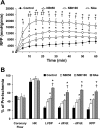
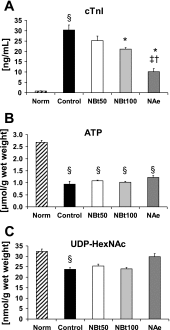
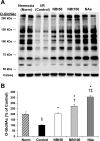

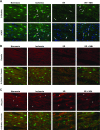

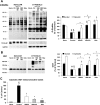
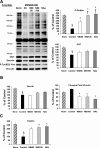
Similar articles
-
Increased O-GlcNAc levels during reperfusion lead to improved functional recovery and reduced calpain proteolysis.Am J Physiol Heart Circ Physiol. 2007 Sep;293(3):H1391-9. doi: 10.1152/ajpheart.00285.2007. Epub 2007 Jun 15. Am J Physiol Heart Circ Physiol. 2007. PMID: 17573462 Free PMC article.
-
Glucosamine protects neonatal cardiomyocytes from ischemia-reperfusion injury via increased protein O-GlcNAc and increased mitochondrial Bcl-2.Am J Physiol Cell Physiol. 2008 Jun;294(6):C1509-20. doi: 10.1152/ajpcell.00456.2007. Epub 2008 Mar 26. Am J Physiol Cell Physiol. 2008. PMID: 18367586 Free PMC article.
-
O-GlcNAc signaling attenuates ER stress-induced cardiomyocyte death.Am J Physiol Heart Circ Physiol. 2009 Nov;297(5):H1711-9. doi: 10.1152/ajpheart.00553.2009. Epub 2009 Sep 4. Am J Physiol Heart Circ Physiol. 2009. PMID: 19734355 Free PMC article.
-
Increasing O-GlcNAc levels: An overview of small-molecule inhibitors of O-GlcNAcase.Biochim Biophys Acta. 2010 Feb;1800(2):107-21. doi: 10.1016/j.bbagen.2009.07.028. Epub 2009 Aug 4. Biochim Biophys Acta. 2010. PMID: 19664691 Review.
-
O-GlcNAcase: promiscuous hexosaminidase or key regulator of O-GlcNAc signaling?J Biol Chem. 2014 Dec 12;289(50):34433-9. doi: 10.1074/jbc.R114.609198. Epub 2014 Oct 21. J Biol Chem. 2014. PMID: 25336650 Free PMC article. Review.
Cited by
-
First characterization of glucose flux through the hexosamine biosynthesis pathway (HBP) in ex vivo mouse heart.J Biol Chem. 2020 Feb 14;295(7):2018-2033. doi: 10.1074/jbc.RA119.010565. Epub 2020 Jan 8. J Biol Chem. 2020. PMID: 31915250 Free PMC article.
-
Functional O-GlcNAc modifications: implications in molecular regulation and pathophysiology.Crit Rev Biochem Mol Biol. 2014 Mar-Apr;49(2):140-163. doi: 10.3109/10409238.2014.884535. Epub 2014 Feb 14. Crit Rev Biochem Mol Biol. 2014. PMID: 24524620 Free PMC article. Review.
-
Immediate effects of a single exercise bout on protein O-GlcNAcylation and chromatin regulation of cardiac hypertrophy.Am J Physiol Heart Circ Physiol. 2013 Jul 1;305(1):H114-23. doi: 10.1152/ajpheart.00135.2013. Epub 2013 Apr 26. Am J Physiol Heart Circ Physiol. 2013. PMID: 23624624 Free PMC article.
-
O-linked beta-N-acetylglucosamine (O-GlcNAc) regulates stress-induced heat shock protein expression in a GSK-3beta-dependent manner.J Biol Chem. 2010 Dec 10;285(50):39096-107. doi: 10.1074/jbc.M110.131102. Epub 2010 Oct 6. J Biol Chem. 2010. PMID: 20926391 Free PMC article.
-
Activation of AKT by O-linked N-acetylglucosamine induces vascular calcification in diabetes mellitus.Circ Res. 2014 Mar 28;114(7):1094-102. doi: 10.1161/CIRCRESAHA.114.302968. Epub 2014 Feb 13. Circ Res. 2014. PMID: 24526702 Free PMC article.
References
-
- Akimoto Y, Kawakami H, Yamamoto K, Munetomo E, Hida T, Hirano H. Elevated expression of O-GlcNAc-modified proteins and O-GlcNAc transferase in corneas of diabetic Goto-Kakizaki rats. Invest Ophthalmol Vis Sci 44: 3802–3809, 2003. - PubMed
-
- Bolli R, Becker L, Gross G, Mentzer R, Jr, Balshaw D, Lathrop DA. Myocardial protection at a crossroads: the need for translation into clinical therapy. Circ Res 95: 125–134, 2004. - PubMed
-
- Champattanachai V, Marchase RB, Chatham JC. Glucosamine protects neonatal cardiomyocytes from ischemia-reperfusion injury via increased protein-associated O-GlcNAc. Am J Physiol Cell Physiol 292: C178–C187, 2007. - PubMed
Publication types
MeSH terms
Substances
Grants and funding
LinkOut - more resources
Full Text Sources
Research Materials

